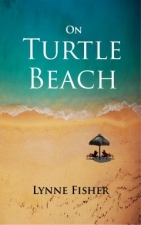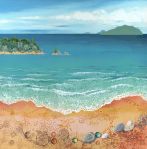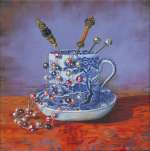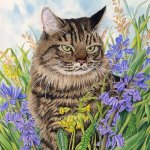This week I’ve been labelling my artworks on Pinterest, which is a website tool and image bank for all creatives of any persuasion (and that includes writers) both for your own work and for collecting inspirations and techniques for future projects. I will come back to Pinterest in a future post. But for now I want to share some fun with you for the new year that can be derived from having a play with digital filters on your own photographs or artwork, whether it be on your iphone with a photo editor installed, or a relatively simple imaging program on your computer such as PaintShop Pro – you really don’t need anything fancy like the latest version of Photoshop to have a worthwhile play so don’t let that put you off. I’ll go through some examples from black and white photography, to colour photography, to actual paintings which you can scan and experiment with.
Back in the late 80s and early 90s I learned black and white photo processing and printing from my hubby, and I remember feeling enchanted by the developed negative having light focused through it to create a negative image through the enlarger, ready for exposing the paper to, where all the black would become white and vice versa. But what I really liked was the negative image itself for its ghostly ethereal properties. Here is an example of what I mean:
This is a photograph of an abbey near me in ‘normal’ black and white in the positive.

But here is what happens if you reverse the tonal values and turn it into a negative.
This is one basic digital filter you can use easily:

Now you can imagine this place haunted by spirits!
But if you decide you want to have a feeling of age, to emphasise its history? Then you can apply a sepia filter and here you have it:

(In the days of black and white photo printing these effects needed infrared film for the ghostly negatives or sepia toner to bathe the black and white print in)
But let’s get a bit more adventurous and turn to colour photography. Complementary colour relationships come into play here by applying a negative image filter, so yellow tones becomes purple, blue tones becomes oranges, red tones become greens. Now if you take colour photographs in muted lighting conditions, the intensity of the colour range remains subtle and thereby the negative images can be more compelling.
Here is a photo I took in low light conditions of some opium poppy heads hanging in a bunch on the back of a kitchen cupboard door. I flipped the image upside down, but you can see there is an orange –brown cast to it.

Here I turned it into a negative image and was stunned by the beautiful grades of blue/greens, so this became my master image.

Then I applied a ‘coloured edges’ filter to it – found within ‘artistic effects’ – just to give it some increased contrast and bulk out the forms a little. This became the final image.

And to show you another filter effect I like, just for visual enjoyment, is ‘glowing edges’ within artistic effects, but which also suggests printmaking possibilties.

One filter I feel is useful for textile project ideas is the ‘glowing edges’ as shown here, from straight colour photograph to the threaded embroidered feel of it with ‘glowing edges’ applied:
Colour photo of some poppies

Becomes this, with glowing edges

And finally to paintings. My paintings are always scanned so I have a record of them and they can be used for prints, but this also gives me the opportunity to play with them and sometimes I end up with two viable colourways of my painting instead of just the original.
Here is the original painting of ‘Winter Hogweed’ – watercolour and mixed media:

And here is its negative image – where the yellows become purples and the blacks become whites, resulting in what I called ‘Hogweed in Blue’:

So just to summarise, here are some simple filters to try, and once you have an effect you like you can play with the colour balance or contrast for more options, and who knows where it will take you!
Black and white/greyscale
Negative image
Colour balance
Gamma adjustments
Coloured edges
Glowing edges
Coloured foil
Hot wax
Possible phone ones could be:
Vintage
Magic pen
Pop art
Gothic
Sketch art
impressionist
So hopefully some interesting creative ideas for you to inject some magic into a grey winter’s day!
















That looks like so much fun! I think the surprise of what the different filters reveal would be a delightful discovery. I’m not much of a tech person, so I don’t use these filters, but in my low tech way, this is a bit like what I do with water — letting water move the color and then seeing what happens as it dries. I’m trying to adapt this same concept to my writing right now (the book I’m working on, not my blog) and I’m discovering a lot there too. Mainly — trust the process!
LikeLiked by 1 person
Yes, it’s that excitement of what may happen, Galen. I’ve been looking into memoir/self help book writing ‘rules’ today, and it seems this is a hybrid form not always appreciated by publishers (they say it should be one or the other), but this format is on the increase with self publishers and readers, so I’m kind of thinking to go with my own flow process irregardless of the ‘rules’ – if it feels right, then maybe it will be…
LikeLike
I agree, Lynne. We shouldn’t have to fit ourselves into anyone else’s categories!
LikeLiked by 1 person
Cheers, Galen…I know this but needed to hear it right now!
LikeLike
thanks Lynne. lots of photographic enhancement ideas for us to absorb. i look forward to your post re Pinterest. i’m on it, but am not very active, as not sure what purpose it serves.
LikeLiked by 1 person
I know exactly what you mean about Pinterest, Libby – but I came across a review of social media outlets for writers and it changed my mind about Pinterest, so I will certainly do a future post on it :>)
LikeLiked by 1 person
What fun creativity and thinking outside of the box can be! I really like the opium poppies photos.
LikeLiked by 1 person
Thanks, Cheryl – you just never know where this kind of experimenting can take you!
LikeLiked by 1 person